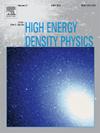电荷对Rastall理论中Tolman IV解各向异性扩展的影响
IF 0.9
3区 物理与天体物理
Q3 PHYSICS, FLUIDS & PLASMAS
引用次数: 0
摘要
本文在Rastall重力框架下,利用扩展的引力解耦几何变形格式,给出了静态自引力系统的精确各向异性球面解。从存在电场的各向同性Tolman IV解开始,我们通过修改时间和径向度量势来引入各向异性。这种方法产生了基于模拟压力和模拟密度约束的两个不同模型。我们分析了Rastall参数、电荷和解耦参数对扩展解的影响,并检查了关键的物理性质,包括活力、稳定性和平衡。在我们的分析中,我们考虑紧凑的恒星物体SMC X-1,其质量M=1.534km,半径I=9.34km。我们的研究结果表明,这两种模型都满足物理生存条件和稳定性。此外,我们建立了托尔曼IV ansatz不受拉斯托重力框架内电场存在的影响。本文章由计算机程序翻译,如有差异,请以英文原文为准。
Effect of charge on anisotropic extensions of the Tolman IV solution in Rastall theory
This study presents exact anisotropic spherical solutions for static self-gravitating systems using the extended geometric deformation scheme of gravitational decoupling within the framework of Rastall gravity. Beginning with the isotropic Tolman IV solution in the presence of an electric field, we introduce anisotropy by modifying both the temporal and radial metric potentials. This approach yields two distinct models based on the mimic pressure and mimic density constraints. We analyze the influence of the Rastall parameter, electric charge, and decoupling parameter on the extended solutions and examine key physical properties, including viability, stability, and equilibrium. For our analysis, we consider the compact stellar object SMC X-1, characterized by a mass and a radius . Our findings indicate that both models satisfy physical viability conditions as well as stability. Additionally, we establish that the Tolman IV ansatz remains unaffected by the presence of an electric field within the Rastall gravity framework.
求助全文
通过发布文献求助,成功后即可免费获取论文全文。
去求助
来源期刊

High Energy Density Physics
PHYSICS, FLUIDS & PLASMAS-
CiteScore
4.20
自引率
6.20%
发文量
13
审稿时长
6-12 weeks
期刊介绍:
High Energy Density Physics is an international journal covering original experimental and related theoretical work studying the physics of matter and radiation under extreme conditions. ''High energy density'' is understood to be an energy density exceeding about 1011 J/m3. The editors and the publisher are committed to provide this fast-growing community with a dedicated high quality channel to distribute their original findings.
Papers suitable for publication in this journal cover topics in both the warm and hot dense matter regimes, such as laboratory studies relevant to non-LTE kinetics at extreme conditions, planetary interiors, astrophysical phenomena, inertial fusion and includes studies of, for example, material properties and both stable and unstable hydrodynamics. Developments in associated theoretical areas, for example the modelling of strongly coupled, partially degenerate and relativistic plasmas, are also covered.
 求助内容:
求助内容: 应助结果提醒方式:
应助结果提醒方式:


